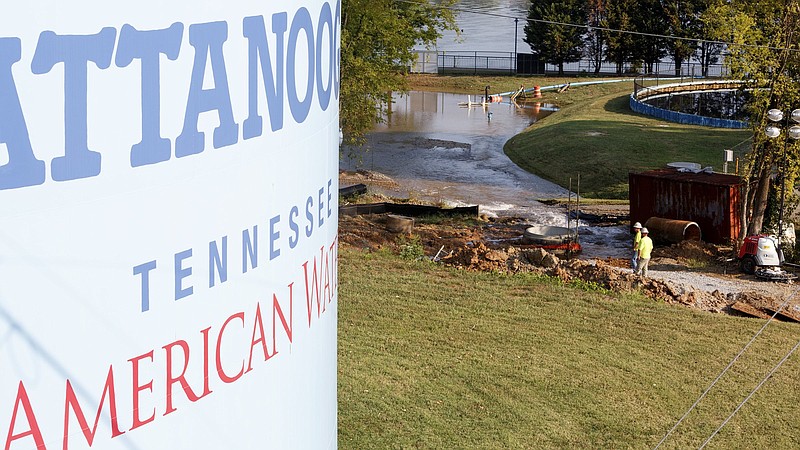To say that Tennessee American Water obfuscated its responsibility to give Chattanoogans answers and confidence in their water utility's trustworthiness last week is being kind.
In fact, on Wednesday when the for-profit water utility company finally deigned to answer any questions about the cause of a water line break that left a large swath of our region without water for three or four days, the only real information imparted was that the utility was calling the debacle its largest water outage in "recent history."
Well, duh.
We got that much information only after our repeated questions to local water company officials, similar repeated requests from elected officials and - finally - Times Free Press reporter Sarah Grace Taylor's dogged and pressuring calls to Tenn Am's corporate headquarters, American Water in New Jersey. Also it probably didn't hurt that a local hot-shot attorney filed a class-action lawsuit over lost business and comfort as a result of the city's long dry weekend in searing heat.
Let's review these pretty simple questions and pretty striking non-answers.
Question 1: What is the company doing to prevent similar outages in the future?
Short answer: The break occurred in the last phase of "an improvement project," (replacing a too-old pipe) and "this project enhances the ability of Tennessee American Water to maintain water service in the event of a main break or other interruption" (meaning it's one less old pipe in the system). Oh, and: "Tennessee American Water is currently engaged in an evaluation of the main break. Due to the complexity of the main break, the evaluation process will take time to conclude." (Translation: We still don't know and/or we're still not saying.)
Question 2: What exact kind of maintenance was underway when the break happened?
Short answer: Workers were installing a valve on a 36-inch water transmission main. During the installation, workers noticed a large amount of water beginning to surface "at a location immediately adjacent to but not part of" the work. "Again, the planned new valve installation was a critical aspect of a larger improvement project." (What did you just say?)
Question 3: What exact kind of repairs were made to the broken main?
Short answer: "A new permanent ductile iron pipe and 36-inch valve were installed. After the repair, valves were turned back on and hydrants were flushed to reduce air and discoloration." (Is that one or two 36-inch valves?)
Question 4: Does the company have any additional details on the cost of repairs, the water lost, the cause of the outage?
Whole answer: "This is all part of the evaluation process underway."
Question 5: What is the process and timeline for gathering this information?
Whole answer: "Again, due to the complexity of the main break, it will take time to conclude this evaluation process." (Yeah. It takes time to stall.)
Over at City Hall and at the County Courthouse, politicians were questioning for the thousandth time what it means for our water system and its aging infrastructure to be operated by "a monopoly."
Suffice it to say, there's bad blood between local officials and Tennessee American as well as its publicly traded parent company, American Water, which operates in 46 states and a few years ago listed its U.S. revenue at $3.3 billion. Some years ago, former Chattanooga Mayor Jon Kinsey and the council at the time waged a lengthy court battle to try taking over the water system from the private company that has operated it for more than 100 years. The company fought the effort and prevailed.
Another former mayor, Ron Littlefield - who in 2010 championed a failed plan to interconnect East Side, Hixson and Tennessee American water infrastructure to harden our water system's resiliency - didn't mince words: "Over the years, [Tennessee American] has been consistently difficult to work with," he said. "They told us, when the plan came up about a decade ago, 'Oh, don't worry. We've got it.' And yet, this weekend, they proved that they never had it under control."
In answering the Times Free Press questions, Tennessee American did make one other point: The company "makes investments" in its systems on a consistent basis. "In fact, Tennessee American Water has invested an average of $18 million annually in capital improvements to the drinking water system over the last five years for a total of $92 million. Projects include replacing pipes, valves, hydrants and meters throughout the system."
Note the word "include" in that comment. They do not tell us what percent of the $18 million went for replacements in the system's 1,400 miles of pipeline vs. what percent went for extending new pipe in new subdivisions and developments. Extensions are no brainers - they mean new customers and new revenue. Replacement line doesn't offer that incentive.
We, however, looked at some other "consistent basis" numbers for Tennessee American. An undated news release on the company's web site announces "Tennessee American Water Submits 2017 Infrastructure Projects." It reads in part: "Infrastructure capital projects planned for 2017 total almost $16 million. The largest capital infrastructure project will be a $2 million river crossing to reinforce" service north of the Tennessee River, and "Tennessee American Water plans to replace approximately 25,500 feet of water main to address aging infrastructure in the community."
So, in 2017, at least, "includes" was about 4.8 miles in 1,400 miles of pipe.
